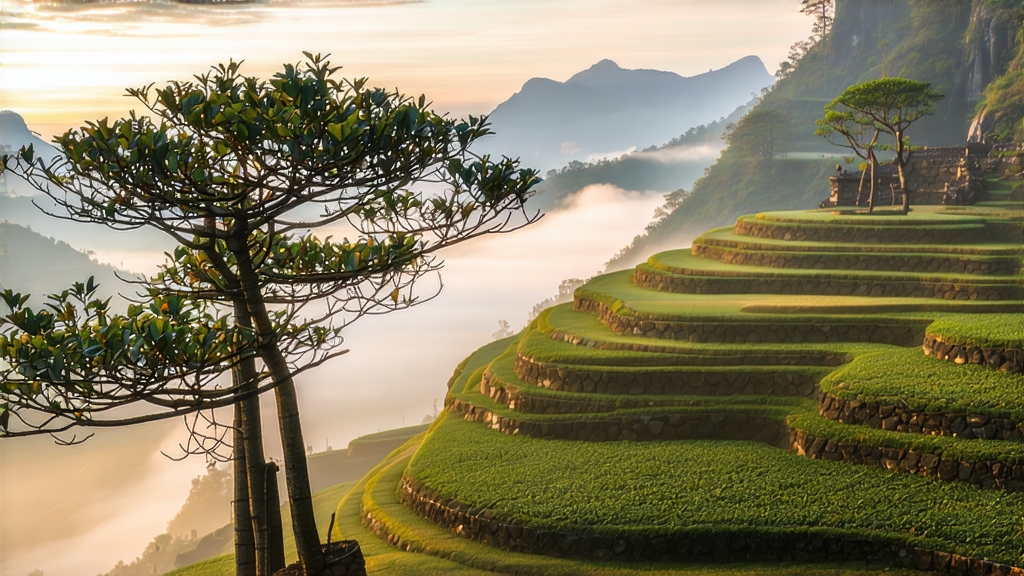
If oolong tea is the jazz of Chinese tea—improvisational, layered, forever balancing between two poles—then Phoenix Dancong is the saxophone solo that makes the whole room fall silent. Grown on the steep, mineral-rich slopes of Phoenix Mountain (Fenghuang Shan) in northern Guangdong, this single-trunk cultivar family has been seducing tea drinkers since the Song dynasty, when imperial scholars first christened it “Song Zhong.” Today, intrepid tea hunters climb the same vertiginous granite paths, searching for 300- to 900-year-old trees whose roots have cracked through bedrock to sip on subterranean springs, concentrating flavor into leaves no larger than a sparrow’s tongue.
History whispers through these terraces. Local She and Hakka minorities still tell the legend of the phoenix that scattered tea seeds across the ridge; each seed became a tree bearing a different fragrance—milan (honeysuckle), yulan (magnolia), Jianghua (ginger flower), almond, cinnamon, even the evanescent “duck-shit” aroma that bears the earthy name Ya Shi Xiang. By the late Ming, Dancong—literally “single bush”—was bartered for salt and silk along the Maritime Silk Road, and Qing-era records show Chaozhou merchants exporting it to Southeast Asia in exchange for teak and spices. The 1985 national tea appraisal in Beijing crowned Mi Lan Xiang (honey-orchid fragrance) as one of China’s top ten famous teas, cementing its global reputation.
Botanically, Phoenix Dancong is Camellia sinensis var. sinensis, but centuries of sexual reproduction among ancient trees have created a living library of over 80 aromatic chemotypes. Unlike the clonal plantations that dominate modern agriculture, each “mother tree” is genetically unique, expressing terroir through volatile compounds such as linalool, geraniol and methyl jasmonate. Elevation matters: bushes above 600 m endure diurnal temperature swings of 15 °C, thick fog and ultra-violet radiation that force the plant to manufacture more aromatic oils. The soil is weathered granite mixed with volcanic tuff, porous and poor in nitrogen—stress that concentrates polyphenols and amino acids into smaller, thicker leaves whose serrated edges curl like tiny dragon claws.
Crafting Phoenix Dancong is a sixteen-step choreography that begins before dawn, when pickers scale 45-degree slopes to pluck only the middle three leaves plus the bud, a standard called “xia kai mian” (open face). The harvest must reach the village workshop by 9 a.m.; any delay oxidizes the leaf edges, flattening the future bouquet. Withering is done first outdoors on bamboo racks called “shai qing,” where leaflets lose 10 % moisture under the high-altitude sun, then indoors on water-heated troughs at 28 °C to coax enzymatic activity. What follows is the most artistic moment: “zuo qing,” or leaf bruising. Masters toss the leaves in a 120 cm diameter rattan basket, rhythmically shaking them against the rim so that cell walls fracture just enough to release aromatic precursors without bruising the stem. The sound—like rain on a tin roof—signals the degree of oxidation; novices listen for a crisp “pa pa” while veterans watch the leaf margins turn copper-red, stopping oxidation at 30–35 %, lighter than Wuyi rock teas but darker than Tie Guan Yin.
Kill-green is performed at 230 °C for exactly four minutes in an iron wok set over lychee-wood embers, arresting oxidation while locking in floral notes. Rolling follows, first empty then loaded, twisting leaves into the signature strip shape that allows gradual release of flavor across multiple infusions. The real signature of Dancong, however, is its charcoal roasting. Using the same “bei huo” technique that Chaozhou potters apply to their famous purple-clay teapots, craftsmen bake the tea over a gentle ember of longan or lychee wood for 6–12 hours, rest it in earthen jars for a month, then repeat the cycle up to three times. Each roasting deepens the honey note, tempers astringency and adds a whisper of smoked caramel that lingers like the memory of campfire on a wool sweater.
To brew Phoenix Dancong properly, one must adopt the Chaozhou gongfu mindset: precision, restraint, and theatrical